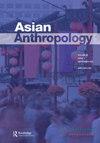全球化的北马拉巴尔的后殖民主义例子:teyyam是一种“艺术形式”吗?
Q2 Social Sciences
引用次数: 0
摘要
摘要喀拉拉邦北部的teyyams人的仪式被称为“艺术形式”、“民间艺术”、“仪式艺术”,不仅被导游和传单所称,还被学术作品所称,越来越多地被当地社区的日常演讲所称。1在这篇文章中,我们打算质疑这种分类的充分性,根据艺术和民间传说的合理定义,并考虑到后殖民环境中社会和政治权力的相关性,调查此类分类的动机。我们为需要综合、知情和谨慎地解决对泰王朝的崇拜(就像任何其他后殖民现实一样)辩护,并认为尽管后殖民话语比殖民言论更有优势,但它仍然可以改进。除了殖民主义文化和政治遗产的明显后果外,还可以通过承认与后来的殖民遗产交织在一起的当地、更古老或离散的影响的痕迹来改进它,并可以为理解复杂性中的当下提供线索。teyyams的例子不是一个随机的选择,而是一个具体的例子,在这个例子中,从前殖民时代延续下来的权力关系的历史一方面在当地的政治讨论中可见,另一方面作为紧张和越轨,以隐喻的方式被充分地刻进了仪式中。本文章由计算机程序翻译,如有差异,请以英文原文为准。
A post-colonial instance in globalized North Malabar: is teyyam an “art form”?
Abstract The ritual of the teyyams, in north Kerala, has been referred to as “art form,” “folk art,” “ritual art,” and such, not only by tourist guides and leaflets, but also by academic works and, more and more, in the everyday speech of local communities.1 In this article we intend to question the adequacy of such categorizations, in light of plausible definitions of art and folklore, and investigate the motivations for such classifications, considering the correlations of social and political power in post-colonial circumstances. We defend a need for an integrated, informed and careful address to the cult of the teyyams (like any other post-colonial reality) and argue that the post-colonial discourse, despite its advantages over colonial rhetoric, can still be improved upon. It can be improved upon by acknowledging, besides the obvious consequences of the colonialist cultural and political heritage, the traces of the local, more ancient or discrete influences, interlaced with the later colonial heritage, and can provide clues for understanding of the present in its complexity. The example of the teyyams is not a random choice but rather a specific example in which the history of the relations of power, which continues from pre-colonial times, is visible on the one hand in local political discussions, and on the other hand has been fully inscribed, as tension and transgression, into the ritual in a metaphorical way.
求助全文
通过发布文献求助,成功后即可免费获取论文全文。
去求助
来源期刊

Asian anthropology
Social Sciences-Anthropology
CiteScore
1.60
自引率
0.00%
发文量
25
期刊介绍:
Asian Anthropology seeks to bring interesting and exciting new anthropological research on Asia to a global audience. Until recently, anthropologists writing on a range of Asian topics in English but seeking a global audience have had to depend largely on Western-based journals to publish their works. Given the increasing number of indigenous anthropologists and anthropologists based in Asia, as well as the increasing interest in Asia among anthropologists everywhere, it is important to have an anthropology journal that is refereed on a global basis but that is editorially Asian-based. Asian Anthropology is editorially based in Hong Kong, Taiwan, and Japan, but welcomes contributions from anthropologists and anthropology-related scholars throughout the world with an interest in Asia, especially East Asia as well as Southeast and South Asia. While the language of the journal is English, we also seek original works translated into English, which will facilitate greater participation and scholarly exchange. The journal will provide a forum for anthropologists working on Asia, in the broadest sense of the term "Asia". We seek your general support through submissions, subscriptions, and comments.
 求助内容:
求助内容: 应助结果提醒方式:
应助结果提醒方式:


